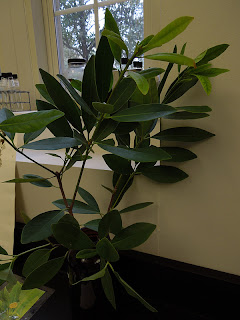Order: Amborellales
Family Amobrellaceae: image
Order: Nymphaeales
Family: Nymphaeaceae (water lilies)
Key features to remember for this family: rhizomotous herbs and aquatic
Nuphar advena (spatterdock)
Nymphaea (hybrid)
The following two pictures were taken in Kanapaha Botanical Gardens here in Gainesville
Order: Austrobaileyales The following two pictures were taken in Kanapaha Botanical Gardens here in Gainesville
Family: Illiciaceae (star anise)
Key features to remember for this family: fuitstar like aggregate of follicles
Order: Magnoliales
Family: Magnoliaceae
Key features to remember for this family:
Note large flowers with separate parts and an elongate receptacle
Magnolia grandiflora
Magnolia virginiana
Fruit of Magnolia amoena
Liriodendron tulipifera (Tulip tree)
Family: Annonaceae (Paw-paw family)Key features to remember for this family: ball of stamens, two rank leaves, globose receptacle
Rollinia deliciosa
This species occurs in mesic hammoks around Gainesville
Asimina parviflora (Paw-paw)
Asimina angustifolia
Annona cherimoya
Annona glabra
Note the two-ranked leaves and the ruminate endosperm
Annona muricata
Note the "ball of stamens"
Cananga odorata
Family: Lauraceae (Avocado family)
Key features to remember for this family: cup-shaped receptacle, stamens with flaps, drupe or berry
Laurus nobilis
Persea borbonia (Red bay)
Persea humilis (silk bay or scrub bay)
This is a close relative of avocado and its fruit is eaten in southern Mexico
Persea scheideana
Persea americana (avocado)
Cinnamomum camphorum
Cinnamomum aromaticum
Cinnamomum cassia
Cryptocarya alba
ORDER: Piperales
Family: Piperaceae (pepper family)
Key features: herbaceous or soft wood, swollen jointed nodes, spike, no perianth
Piper methysticum (kava)
Piper nigrum (source of black pepper)
Piper auretum
Peperomia verticilata
Peperomia prostrata



























































No comments:
Post a Comment